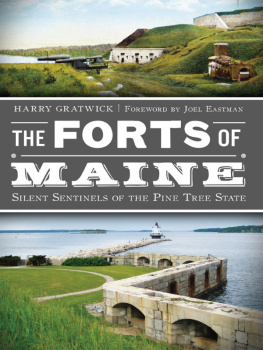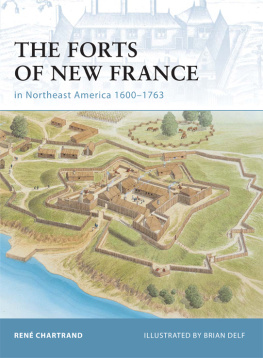The National Archives - Forts
Here you can read online The National Archives - Forts full text of the book (entire story) in english for free. Download pdf and epub, get meaning, cover and reviews about this ebook. year: 2018, publisher: Bloomsbury Publishing, genre: History. Description of the work, (preface) as well as reviews are available. Best literature library LitArk.com created for fans of good reading and offers a wide selection of genres:
Romance novel
Science fiction
Adventure
Detective
Science
History
Home and family
Prose
Art
Politics
Computer
Non-fiction
Religion
Business
Children
Humor
Choose a favorite category and find really read worthwhile books. Enjoy immersion in the world of imagination, feel the emotions of the characters or learn something new for yourself, make an fascinating discovery.
- Book:Forts
- Author:
- Publisher:Bloomsbury Publishing
- Genre:
- Year:2018
- Rating:4 / 5
- Favourites:Add to favourites
- Your mark:
- 80
- 1
- 2
- 3
- 4
- 5
Forts: summary, description and annotation
We offer to read an annotation, description, summary or preface (depends on what the author of the book "Forts" wrote himself). If you haven't found the necessary information about the book — write in the comments, we will try to find it.
Forts — read online for free the complete book (whole text) full work
Below is the text of the book, divided by pages. System saving the place of the last page read, allows you to conveniently read the book "Forts" online for free, without having to search again every time where you left off. Put a bookmark, and you can go to the page where you finished reading at any time.
Font size:
Interval:
Bookmark:


FOR PETER CLARKE
OSPREY PUBLISHING
| Osprey Publishing | Bloomsbury Publishing Inc. |
| Bloomsbury Publishing Plc | 1385 Broadway, 5th Floor, |
| PO Box 883, Oxford, | New York, |
| OX1 9PL, UK | NY 10018, USA |
E-mail:
www.ospreypublishing.com
This electronic edition published in 2018 by Bloomsbury Publishing Plc
OSPREY is a trademark of Osprey Publishing Ltd
The National Archives logo Crown Copyright 2018
The National Archives logo is a trade mark of The National Archives and is used under licence.
First published in Great Britain in 2018
Jeremy Black 2018
Jeremy Black has asserted his right under the Copyright, Designs and Patents Act, 1988, to be identified as Author of this work.
For legal purposes the constitute an extension of this copyright page.
All rights reserved
You may not copy, distribute, transmit, reproduce or otherwise make available this publication (or any part of it) in any form, or by any means (including without limitation electronic, digital, optical, mechanical, photocopying, printing, recording or otherwise), without the prior written permission of the publisher. Any person who does any unauthorised act in relation to this publication may be liable to criminal prosecution and civil claims for damages.
A catalogue record for this book is available from the British Library.
ISBN: 978-1-4728-2763-0 (HB)
ISBN: 978-1-4728-2762-3 (eBook)
ISBN: 978-1-4728-2761-6 (ePDF)
ISBN: 978-1-4728-3542-0 (XML)
Design by Nimbus Design
: Detail from WO 78/317 (3) Mahon Harbour Minorca 177275 (The National Archives).
To find out more about our authors and books visit www.ospreypublishing.com. Here you will find our full range of publications, as well as exclusive online content, details of forthcoming events and the option to sign up for our newsletters. You can also sign up for Osprey membership, which entitles you to a discount on purchases made through the Osprey site and access to our extensive online image archive.
CONTENTS
PREFACE
Centres for defence and bases for attack, fortifications are a crucial aspect of military history. Their remains offer a still potent, and often dramatic, testimony to the strength of these sites and the power of these works. This book provides a history of fortifications based on their presentation in maps and plans. The potential threat posed by siegecraft is also considered.
As emerges repeatedly in this book, there is no clear definition of fortification. Visiting Japanese castles or German coastal defences on Guernsey, this might appear absurd, but there are, in practice, many issues of definition. To take just those examples, is a castle less of a fortification if its prime function was residential or to act as a jail? Are the German submarine pens on the west coast of France, ones that remain impressive to this day, any less fortifications because they protected the submarines against air attack? These are all dramatic examples of fixed fortifications. But what of the relationship with those that were not fixed, and never intended to be fixed? They were fortifications and designed for protection. Here we really are in conceptual, methodological and historiographical difficulties. If the emphasis is on protection then, at the individual level, armour or any form of protective clothing is fortification. If we move to the use of temporary or enhanced positions, then the trench hastily dug or the farmhouse with bolted windows and doors becomes a fortification. That approach may appear mistaken, but, given the emphasis in recent literature on both insurgencies and counterinsurgency warfare, it appears mistaken to omit the relevant defences from any discussion of fortifications. So also with irregular warfare and, indeed, with changing patterns of symmetrical conflict.
The ambiguous nature of warfare extends to the dubious use of the language of warfare to discuss very different activities. This can be seen, for example, with the use of the language of war, defences and attack to describe cancer and other diseases. There is less confusion if policing or law and order are considered because a major purpose of fortifications was indeed to provide internal security and this could be directed as much against lawlessness as against rebellion. In this case, as others, fortification ensures or enhances the capacity for defence. That point can then be taken further, into fresh fields for conceptual uncertainty, by thinking first of the fortified nature of weapons and platforms designed for, or at least used for, defensive purposes, for example, armoured trains, as in the Russian Civil War. Second comes the fortified nature of those used for attacking purposes, as with armour and secondary defensive weaponry on warships or aircraft. The notion of a bomber as a Flying Fortress captures only part of its function, and certainly not that which might be more accurately conveyed by an interceptor fighter designed to block such bombers. To add to the complexity, escort fighters (and the equivalent warships) have defensive tasks as part of the process of fortifying, i.e. protecting, the strike force.
To offer a clear definition of logical weight is not credible. Here a number of criteria are offered. There is no discussion of the situation as far as war at sea or war in the air are concerned. There is, however, full consideration of non-fixed alongside fixed fortifications; although this non-fixed character does not extend to vehicles, whether chariots or tanks. Although body armour will be mentioned, the emphasis is very much not on the protection and fortification of individuals. Instead, the enhancement of their protection by means of positional defences, whether permanent or not, is the subject. Correspondingly, the means employed to attack these defences will also be considered, although siegecraft focuses far more on fixed defences. Ultimately, the intention is to encourage readers to think widely about the subject. Reflecting on its complexities, not least in definitional terms, is part of this process of thought.
In one respect, the history of fortification is a history of mankind, indeed a global history. I have benefited from opportunities to visit fortifications around the world, from Japan to the United States, New Zealand to Panama, and to lecture at a number of fortified sites, including the Tower of London and the positions at Yorktown. While working on this book, I particularly profited from being asked to lecture on a tour to Peninsular War battlefields. I am most grateful to Stephen Church, Kelly DeVries, John France, Bob Higham, Kaushik Roy, and Ulf Sundberg for their advice on all or much of an earlier draft. Lisa Thomas has proved a most helpful editor. This book is dedicated to Peter Clarke, who shares my interest in military history and is the partner of Wendy Duery, a work collaborator whose help over the years has been greatly appreciated.

FORT EDWARD, NEW YORK 1757 The structure was constructed in 1755 as a fort in the French and Indian War.
O RIGINS

Font size:
Interval:
Bookmark:
Similar books «Forts»
Look at similar books to Forts. We have selected literature similar in name and meaning in the hope of providing readers with more options to find new, interesting, not yet read works.
Discussion, reviews of the book Forts and just readers' own opinions. Leave your comments, write what you think about the work, its meaning or the main characters. Specify what exactly you liked and what you didn't like, and why you think so.











